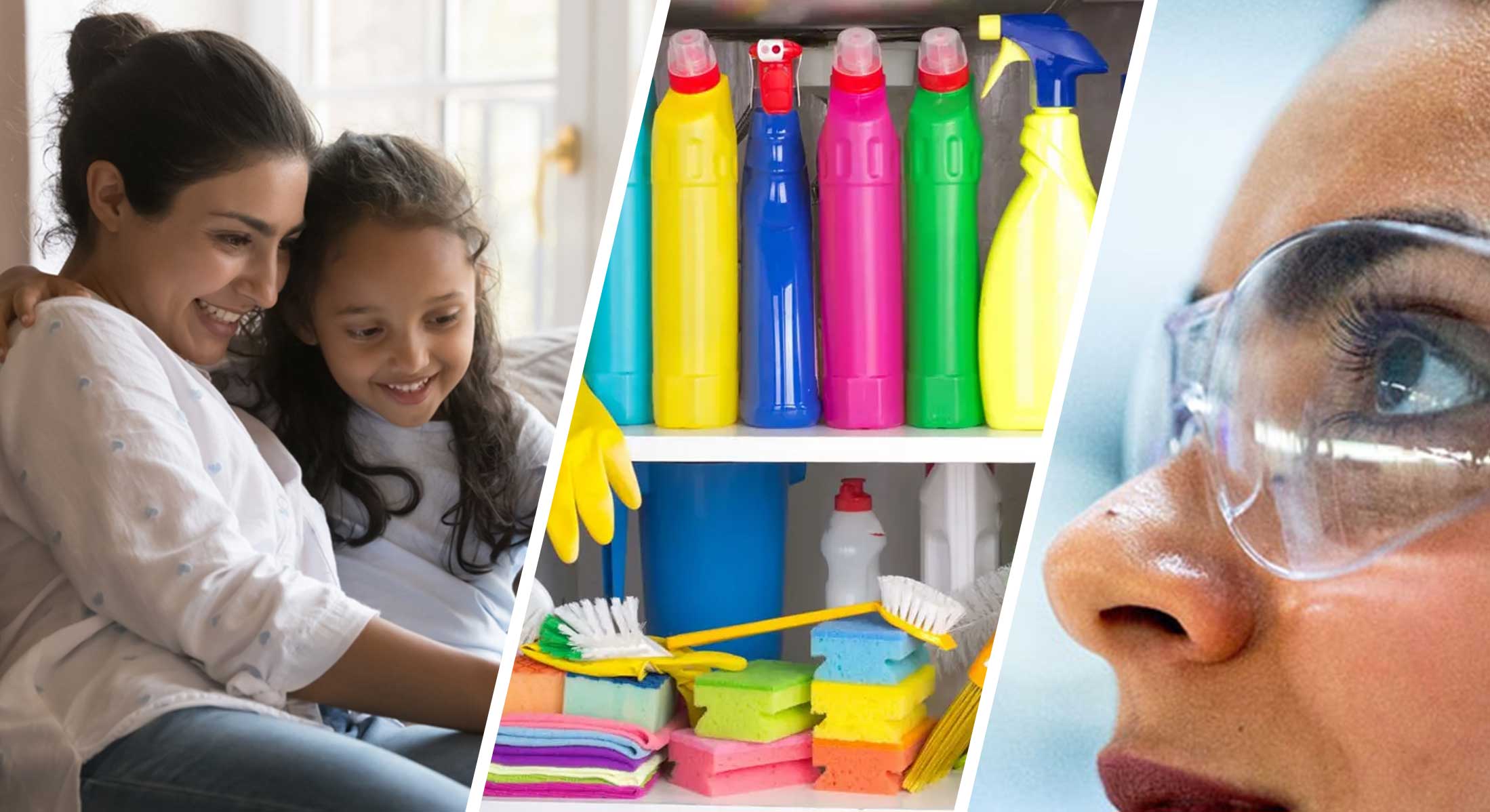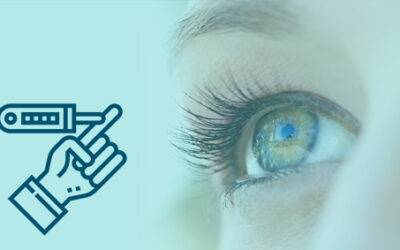Eye Safety at Home – Tips to Prevent Eye Injuries

Types of Eye Injuries at Home
T here are many different eye injury types that can occur at home, such as a chemical eye injury, penetrating eye injury, traumatic eye injury, or blunt eye injury. Most common types of eye injuries at home can be caused by:- Household Chemicals – Products such as cleaning liquids or detergents, pesticides, bleach, or ammonia can accidentally come into contact with your eyes when doing household chores. The chemicals in them can cause irritation, redness, burns, or even permanent damage to your vision.
- Blunt Force Trauma – Accidents such as walking into furniture, falling down the stairs or on a slippery floor, or bumping your head on a low-hanging cabinet can result in physical injuries to your eyes. This can cause pain, swelling, bruising, and possible internal damage which can lead to vision changes that can be temporary or permanent.
- Accidental Injuries – Careless handling of common household tools such as sharp knives, scissors, or bottle openers, toys with sharp edges, keys, nail cutters, stationery, or hot curling irons around the face can pose the risk of serious eye injuries. These objects can cause cuts, scrapes, or punctures to the eye or surrounding area, which can be severe and require medical attention.
- Cooking – Common eye injuries associated with cooking include burns from hot oil or grease splashes, and contact with smoke or irritating foods like hot peppers.
- Sports and Recreational Activities – Home is where we relax, but it’s also where we play. Activities like playing badminton or skipping, catching a ball or a frisbee, knitting or art work can lead to eye injuries from flying objects or projectiles.
- Gardening and Home Improvement – When gardening, mowing the lawn, trimming hedges, or using hand and power tools in your house, your eyes may be exposed to airborne pollen and dust, chemicals such as fertilizers and pesticides, or get injured by flying debris such as small particles of leaves, wood chips, or debris.
- Cosmetics – Beauty products such as hair dye, mascara, eyeliner, eyeshadow or nail polish remover can cause eye injuries in a variety of ways, including burning and irritation from preservatives, chemicals, or fragrances; allergic reactions from certain ingredients, such as nickel, cobalt, or parabens; infections from unclean makeup brushes or expired eye makeup; and corneal scratches from mascara wands or eyeliner pencils.
Symptoms of Eye Injuries at Home
E ye injuries can happen unexpectedly at home, and recognizing their symptoms is crucial for timely and appropriate intervention. The severity of eye injury symptoms can vary from mild scratches to serious penetrating wounds depending on the type of eye injury. Here are some common symptoms of eye injuries that can occur in a household setting:- Pain and Discomfort – One of the most immediate signs of an eye injury is pain or discomfort. If you experience any form of eye pain, it is essential to investigate the cause.
- Redness and Irritation – This can be indicative of a foreign object or a chemical substance coming into contact with the eye. It may also signal an infection or injury.
- Swelling and Bruising – Swelling around the eye, along with bruising, is often a sign of blunt force trauma or injury to the eye socket. This should be taken seriously, as it may involve damage beyond the surface.
- Bleeding – Any bleeding from the eye or the area around the eye should be treated as an emergency, as it can signify a severe injury that requires immediate medical attention.
- Blurry Vision – Blurry vision can result from a variety of eye injuries, such as corneal abrasions or blunt force trauma. If your vision suddenly becomes unclear, it is a sign that something may be wrong.
- Double Vision – Double vision, or seeing two images instead of one, may be associated with certain eye injuries, particularly those affecting eye alignment or the optic nerve.
- Decreased or Loss of Vision – A sudden decrease in vision or complete loss of vision in one or both eyes is a serious symptom that requires immediate medical intervention.
- Sensitivity to Light – If you find yourself squinting or experiencing discomfort in bright light, it could be a symptom of an eye injury or underlying eye condition.
- Excessive Tearing – An increased flow of tears can be your body’s natural response to an eye injury, attempting to flush out irritants or foreign objects. However, persistent tearing may indicate an ongoing issue.
- Foreign Body Sensation – A feeling of something being stuck in your eye, even if you can’t see anything, can indicate the presence of a foreign object on the eye’s surface or under the eyelid.
It is important to note that some eye injuries may not exhibit immediate symptoms or may develop gradually. If you suspect an eye injury or experience any of these symptoms, it is advisable to seek prompt medical attention. Even if the injury seems minor, or you are unsure whether or not you have an eye injury, it is always best to err on the side of caution and have it evaluated by an eye doctor to rule out any serious problems. Remember that early detection and treatment can significantly improve the outcome and prevent long-term damage to your vision.
Eye Injury Prevention – Safety Tips to Prevent Eye Injuries at Home
T he best way to prevent eye injuries at home is to be aware of the potential hazards and to take steps to avoid them. Here are some safety tips:- Wear Protective Eyewear – Whenever you are engaged in activities that could pose a risk to your eyes, wear appropriate eye protection. Safety goggles or safety glasses with side shields are essential for DIY projects or gardening, when using power tools or working with chemicals, and playing sports.
- Store And Use Chemicals Safely – Keep household chemicals out of reach of children and pets. Always read and follow the product use guidelines on the labels. Avoid haste when handling chemical solutions as doing so increases the risk of spills and splatters. Ensure that the spray nozzles on bottles are directed away from you before using the product. When using household chemicals, avoid touching your eyes and face.
- Childproof Your Home – Install safety gates, secure sharp objects and tools out of reach, and cover electrical outlets to prevent children from accessing dangerous items or areas. Parental supervision during playtime can prevent toy-related eye injuries to children. Avoid buying toys that are not age-appropriate and those with sharp edges or elastic that might snap into the eyes.
- Prevent Falls – Clear clutter and keep your home tidy to reduce the risk of tripping and falling, which can lead to blunt force trauma to the eyes. Secure rugs with non-skid pads, fix hand railings to staircases, add nightlights in hallways, and use corner guards on furniture and cabinets.
- Exercise Care When Applying Makeup – Be very careful when using mascara wands or tweezers around your eyes as a slip of the hand can lead to a serious eye injury. Check the expiry date and ingredients of cosmetic products before using them and ensure your make-up brushes are clean.
- Use Caution in the Kitchen – To prevent burns and chemical splashes from simmering sauces when cooking, use splatter guards and avoid standing too close to hot oil or steam. Refrain from touching your eyes or your face when handling spicy food. Be careful when handling sharp knives and when opening champagne bottles or other sparkling beverages.
First Aid for Eye Injury – Steps to Take if an Eye Injury Occurs
I f you do have an eye injury, it is important to seek medical attention immediately. However, there are some things you can do to provide first aid before you see a doctor:- Don’t Rub Your Eye – If something gets into your eye, resist the urge to rub it. Rubbing can worsen the injury.
- Flush with Water – If a chemical or foreign object enters your eyes, try to immediately flush it out with clean water. Hold your eyelids open and let the water run gently over your eye for at least 15 minutes.
- Cover the Eye – If you’ve sustained a penetrating wound or blunt force injury, or there’s bleeding, cover the injured eye with a clean, sterile bandage or cloth, and seek immediate medical help.
- Consult an eye doctor – Even if the eye injury or irritation seems to improve, it is essential to see an eye doctor to rule out permanent eye damage. Some injuries may not be immediately apparent but can cause long-term damage if left untreated.
Conclusion
E ye injuries at home are more common than we might think, but they are largely preventable with some awareness and precautionary measures. By understanding the types of eye injuries that can occur at home, following safety tips, and knowing what to do in case of an accident, you can protect your precious vision and ensure a safer environment for yourself and your loved ones. Remember, your eyesight is invaluable, so let’s all keep an eye out for safety at home.
Read More Eye Care Blogs
4 Eye Problems That Can Result from Diabetes
If you are a diabetic, it means that the blood glucose or blood sugar in your body is too high. Most of the food you eat is broken down by your body into glucose - the main source of energy that is used for the various functions of the body. Insulin (a hormone made by...
Safeguarding Young Eyes – A Comprehensive Guide to Preventing Eye Injuries in Children
s parents, guardians, and caregivers, safeguarding our children's well-being is always at the forefront of our minds. Yet, amidst all the protective measures we take, we may inadvertently overlook a crucial aspect of their health - their eyes. Eye...
Celebrate Deepawali Safely – Eye Safety Tips for a Bright and Injury-Free Festival
Celebrate Deepawali Safely - Eye Safety Tips for a Bright and Injury-Free Festival eepawali, the festival of lights, is a time of celebration and joy for millions of people in India and across the world. It's a time when families come together,...





